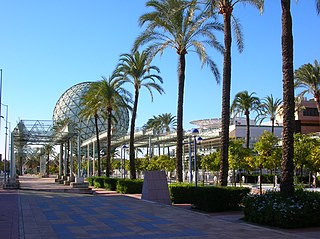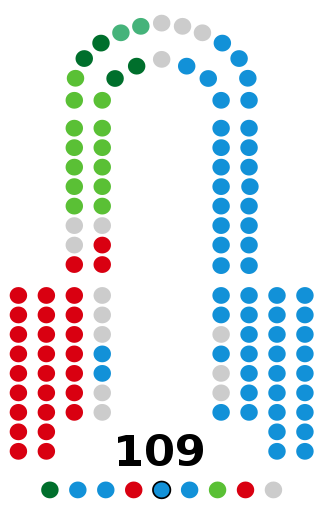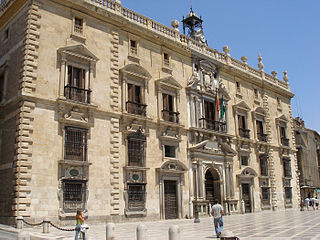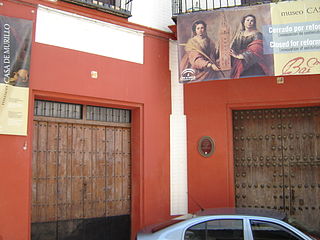
Andalusia is the southernmost autonomous community in Peninsular Spain. It is the most populous and the second-largest autonomous community in the country. It is officially recognised as a historical nationality and a national reality. The territory is divided into eight provinces: Almería, Cádiz, Córdoba, Granada, Huelva, Jaén, Málaga, and Seville. Its capital city is Seville. The seat of the High Court of Justice of Andalusia is located in the city of Granada.

Spain is a country located in southwestern Europe occupying most of the Iberian Peninsula. It also includes a small exclave inside France called Llívia, as well as the Balearic Islands in the Mediterranean, the Canary Islands in the Atlantic Ocean 108 km (67 mi) off northwest Africa, and five places of sovereignty on and off the coast of North Africa: Ceuta, Melilla, Islas Chafarinas, Peñón de Alhucemas, and Peñón de Vélez de la Gomera.

Isla de la Cartuja is an island in the Guadalquivir River at Seville, Spain.

The Andalusians are the people of Andalusia, an autonomous community in southern Spain. Andalusia's statute of autonomy defines Andalusians as the Spanish citizens who reside in any of the municipalities of Andalusia, as well as those Spaniards who reside abroad and had their last Spanish residence in Andalusia, and their descendants. Since reform in 2007, the Andalusian statute of autonomy identifies the territory as a historic nationality in the preamble. The Spanish Language Academy recognizes Andalusian Spanish as a set of diverse dialects. Andalusian nationalism is the belief that Andalusians are a nation separate from other ethnicities within Spain.

Cuevas Bajas is a town and municipality in the province of Málaga, part of the autonomous community of Andalusia in southern Spain. It belongs to the comarca of Nororma. It is part of the judicial district of Archidona. The municipality is situated 75 kilometers from Málaga and 495 km from Madrid In 2011 it had a population of 1,482 inhabitants. Its surface area is 16.53 km2. Cuevas Bajas has a density of 89.66 inhabitants/km2. The natives are called Cueveños.

The Parliament of Andalusia is the legislature of the Spanish autonomous community of Andalusia instituted by the Andalusian Charter of Autonomy of 1981. It is elected by the residents of Andalusia every four years.

Albuñuelas is a village at the head of the Lecrin Valley, Granada, Spain. It is made up of three neighbourhoods (barrios): Alto, Bajo and Fernán Núñez. It is situated on the European route Nº 4.

Santa Cruz del Comercio is a municipality located in the province of Granada, Spain. According to the 2005 census (INE), the city has a population of 544 inhabitants.

Alto Guadalquivir is a Spanish comarca in the province of Córdoba. It covers an area of 1,299 km², and has a population of 44,828 inhabitants. It borders the comarca of Valle de los Pedroches to the North; Campiña Este - Guadajoz to the South; Córdoba and the comarca of Valle del Guadiato to the West; and the province of Jaén to the East.

The High Court of Justice of Andalusia, Ceuta and Melilla, is the highest court of Andalusia, and for the Spanish autonomous cities of Ceuta and Melilla. Its seat is the former Royal Chancery of Granada. The TSJA has full power over all the jurisdictional orders: civil and penal law, social law, administrative disputes, and any other orders that may be created in the future.

The Casa de Murillo is a historical house in Seville, Andalusia, Spain, at number 8, calle Santa Teresa, in the historic Barrio de Santa Cruz. It was the home of the painter Bartolomé Esteban Murillo (1617–1682) in the latter years of his life. The building has two storeys and a central patio (courtyard) with columns.

El Alia is a town and commune in the Bizerte Governorate, Tunisia.

Ras Jebel, also known as Ras el-Djebel, is a town, commune, and archaeological site on Cap Sidi in the Bizerte Governorate of Tunisia. The name of the city refers to the summit or end of the mountain, thus evoking the end of the Atlas Mountains.

La Casa de Pilatos is an Andalusian palace in Seville, Spain, which serves as the permanent residence of the Dukes of Medinaceli. It is an example of an Italian Renaissance building with Mudéjar elements and decorations. It is considered the prototype of the Andalusian palace.

The Romería de El Rocío is a procession/pilgrimage on the second day of Pentecost to the Hermitage of El Rocío in the countryside of Almonte, Province of Huelva, Andalucia, Spain, in honor of the Virgin of El Rocío. In recent years the Romería has brought together roughly a million pilgrims each year.

The International University of Andalucía or UNIA is a university in Andalusia, set up in 1994 to complete the region's educational system. It offers postgraduate and specialty courses. It has campuses in four Andalusian provinces: Huelva, Jaén, Málaga, and Seville.
The Battle of Lopera took place between 27 and 29 December 1936 during the Spanish Civil War. This battle took place during the Nationalist's Aceituna offensive. On 27 December, the XIV International Brigade launched an attack in order to occupy the Nationalist-held town of Lopera, but the attack failed after two days and the Brigade suffered appalling casualties.

San Miguel is a Roman Catholic church in Córdoba, Andalusia, southern Spain. It is one of the twelve churches built by order of King Ferdinand III of Castile in the city after its conquest in the early 13th century. It was declared a monument of national interest in 1931.

San Lorenzo is a church in Córdoba, Andalusia, southern Spain. Situated in the historic centre, it was one of the twelve religious buildings commissioned by king Ferdinand III of Castile in the city after its conquest in the early 13th century.

The University of Córdoba, is a university in Córdoba, in Andalusia, Spain, chartered in 1972. It offers undergraduate and postgraduate studies in humanities, social sciences, health sciences, natural sciences and engineering.


















